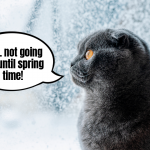Dried meat, freeze-dried morsels, creamy pastes – we don’t know a cat that would resist the offer of treats. But these, besides their undeniable taste qualities, can also be useful to us, the Guardians, as a tool for work (and a form of feline bribery). When a cat recognizes the sound of their favorite treats’ packaging, they’re capable of doing a lot for them. Today, we’ll explore together with you, fabCats, how to use treats for working with furballs.
Treats every cat will love
Although cats are obligate carnivores, they have quite a variety of healthy snacks to choose from, and there’s probably no cat that wouldn’t find at least one Holy Grail among the plethora of cubes, sticks, pastes, and dried fillets. Similar to choosing regular food, when selecting treats, it’s worth paying attention to the snack’s ingredients. However, many Guardians have somewhat looser selection criteria in this regard. The main rule: choose meat, and avoid unnecessary preservatives and carbohydrates. The shorter the list of ingredients, the better, and if it’s 100% meat, that’s even better.
You can read about different ways of feeding cats (and choosing good food) on our blog: https://blog.mykotty.pl/en/2021/05/04/different-ways-to-feed-a-cat-dry-food-wet-food-barf-and-whole-prey/
When selecting treats, we naturally focus on what will work for our cats. Some furballs prefer dried, freeze-dried meat bits, others go crazy for dried fillets, and yet others agree to anything for a tube of tasty paste. Even fillet-based cat foods can serve as treats – aromatic broth and tasty meat can work like a magnet for some furballs.
Nutritional values of cat treats
When offering treats to a cat, we must remember that before they were dried or freeze-dried, they were sizable pieces of meat. And that means… calories! Unfortunately, just like with us humans, indulging in treats without control isn’t the best or healthiest idea. The optimal solution is to include the amount of treats consumed throughout the day in the overall caloric intake of all the meals we give the cat from morning till evening. This is especially important when we need to ensure the cat’s proper weight. Treats aren’t a complete meal, so over the course of the day, they should only be a small addition, not the caloric equivalent of a full meal.
How to use treats when working with a cat?
Treats play an important role in familiarizing a cat with various activities – both pleasant ones like play and training, and less favored ones by furballs, such as nail trimming, teeth brushing, brushing, or traveling. They can also be an effective way to reduce unwanted behaviors in a cat – when a cat refrains from scratching the couch or jumping on countertops, they get rewarded instead. For many furballs, this is enough motivation to tolerate the rules set by humans. And if there’s a treat involved for using the scratcher or sinking their claws into it? That’s a win!
Cats fundamentally strive to avoid harm in life. They also strongly base their approach to situations on past experiences, avoiding those that were physically or mentally uncomfortable, and induced fear or pain in the past. Using rewards allows us to create positive associations for the cat with a given situation – rewards are more effective than punishment, as a cat wants to feel comfortable and willingly follows it. A cat will never ask for punishment, but when the stake is a reward… a lot can be done for a tasty treat.
Treats as a reward for good behavior. This is the most valuable application of treats in a cat’s diet. It allows us, the Guardians, to shape feline behavior in such a way that furballs will tolerate certain situations more easily and feel better about performing certain tasks, even if they don’t particularly like them. A simple example: nail trimming. Cats accustomed to this procedure from a young age usually cope better, but it’s generally not a procedure that cats love. However, if tasty rewards come into play and the nail trimming itself doesn’t cause physical discomfort to the cat, over time the cat will learn that when the clippers appear, something delicious follows right after. This training can take time, depending on how receptive the cat is to learning and how long it associated a certain action with something negative and unpleasant, but there are cats that quickly catch on – good behavior equals a reward.
Treats for play. Not all cats love chasing after prey and active forms of hunting – there are furballs for whom solving problems is a much more attractive activity. How do I approach a toy to catch it in one go? How long can I watch a fly on the wall without it escaping? Treats are a wonderful way to stimulate a cat’s mental work. With their help, you can teach your furry friend to give a paw, lie down on command, perform spins, and other tricks. It’s great fun and also a time for strengthening the bond between the Guardian and the cat. Treats can also be used in scent-based games and as a hunting element. Sprinkled into a sniffing mat or an interactive toy, they compel the cat to solve a puzzle to get the tasty reward. And if you want to awaken the hunter’s spirit in your cat, but they’ve lost interest in chasing a fishing rod, fetching treats, or attaching a larger piece of dried meat to the fishing rod is a good way to stimulate hunting instincts. After “catching” such “prey,” the cat can play with it and consume it, which perfectly closes the natural hunting cycle.
Trick the cat – play and train with treats
Cats love rewards. They adore the sense of satisfaction from a successful hunt and being rewarded for completing a task. And although we obviously can’t give treats to our cats for every little achievement, it’s definitely worth using this tasty method to work with cats. The cat benefits from it, but so does the Guardian – when you give your cat treats, they start to associate you with nothing but good memories. It’s a simple and enjoyable way to gain feline trust, strengthen the relationship, and master a few challenging tasks that are inevitable in a life with cats.
So, what role do cat treats play in your homes, fabCats? Are they just a tasty snack, or a valuable reward? Let us know in the comments and share the names of your furballs’ favorite treats 🙂




